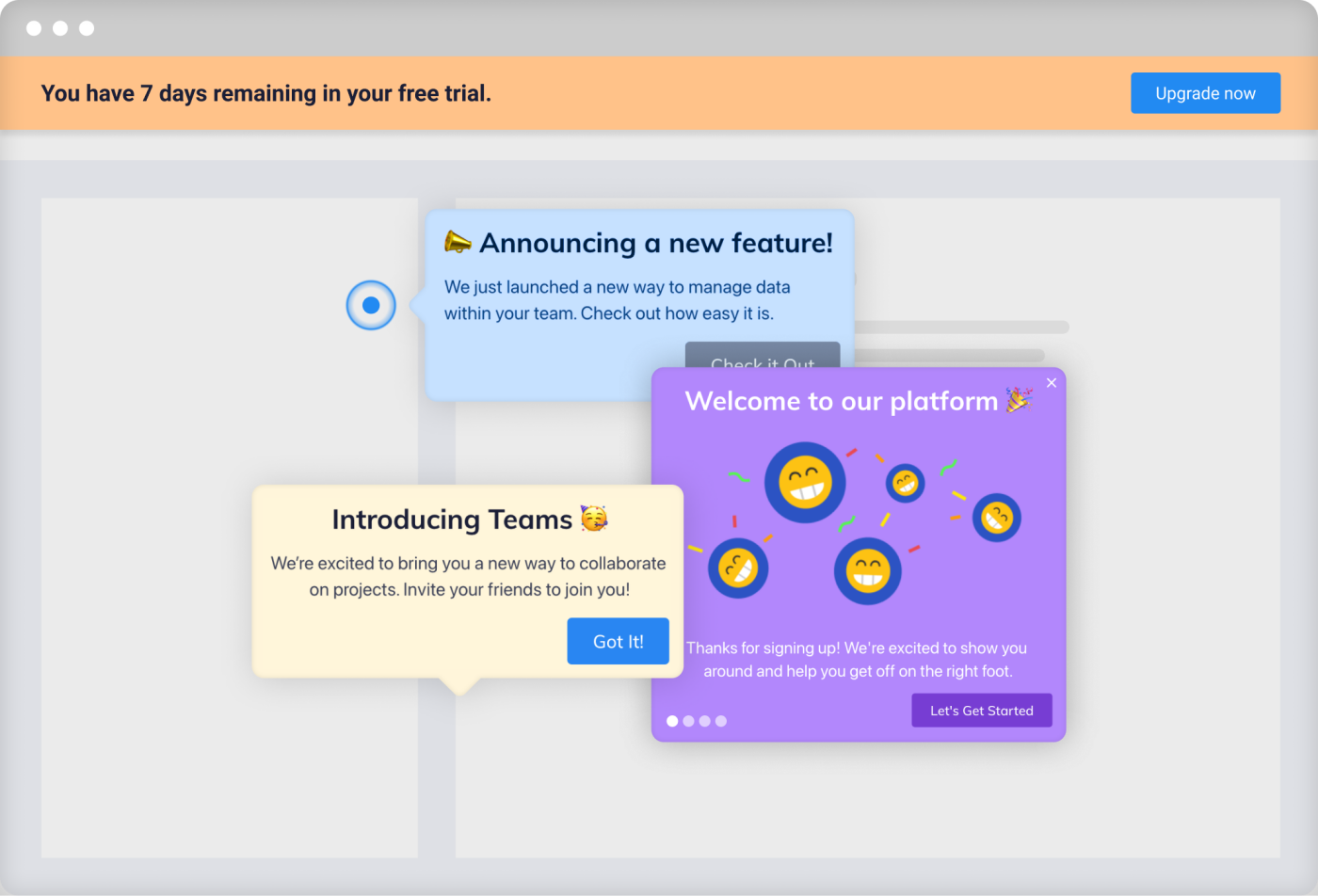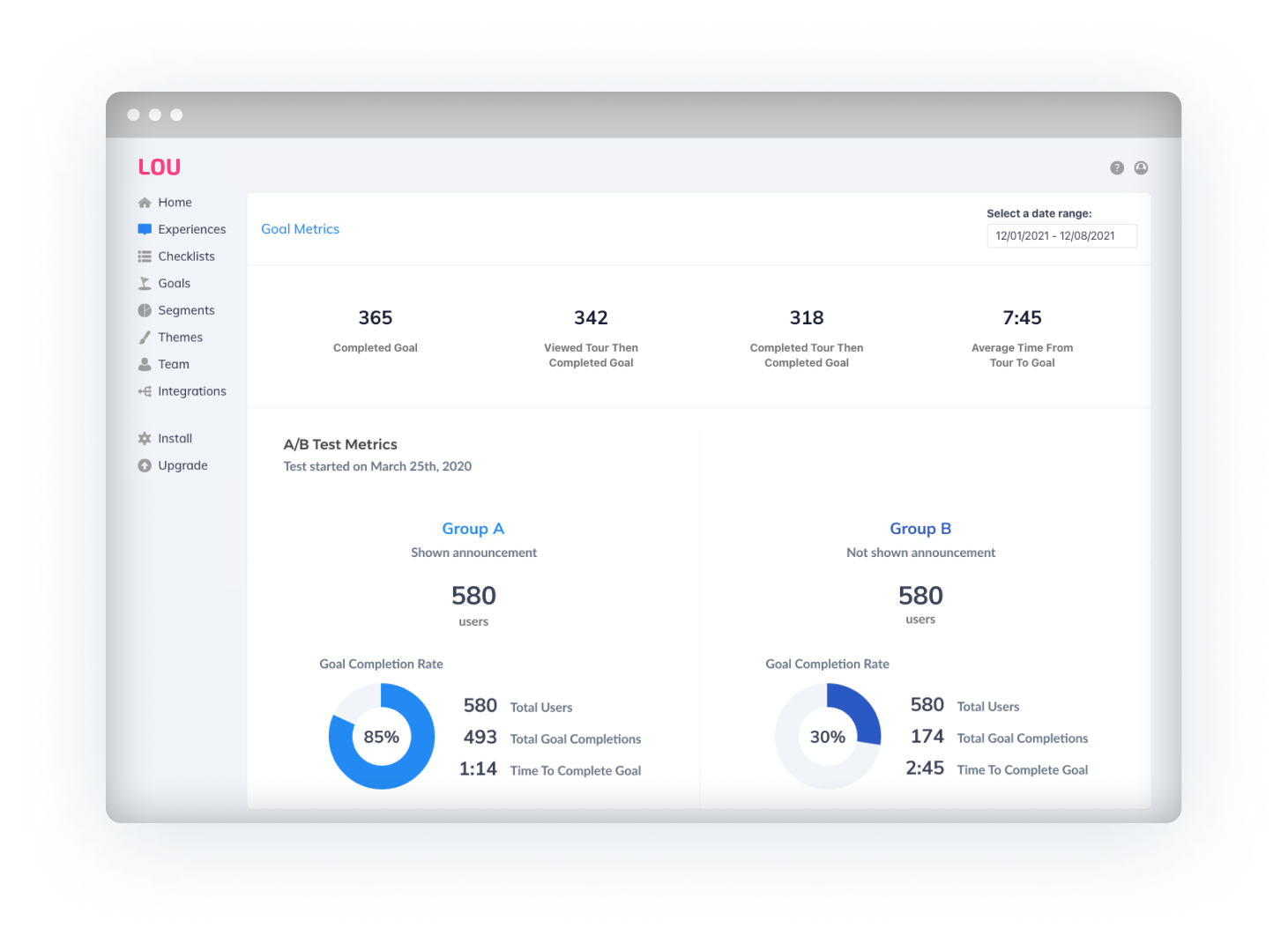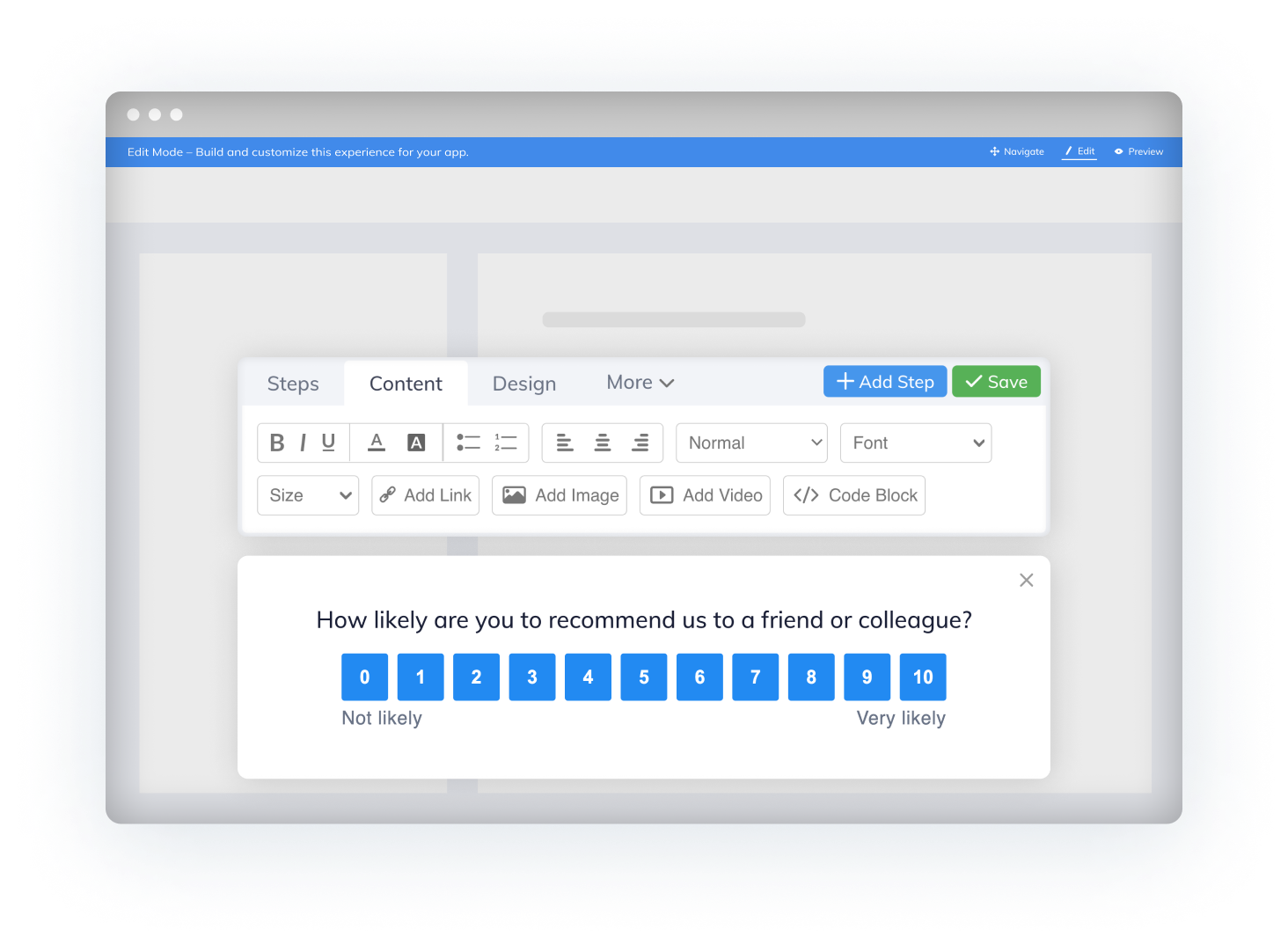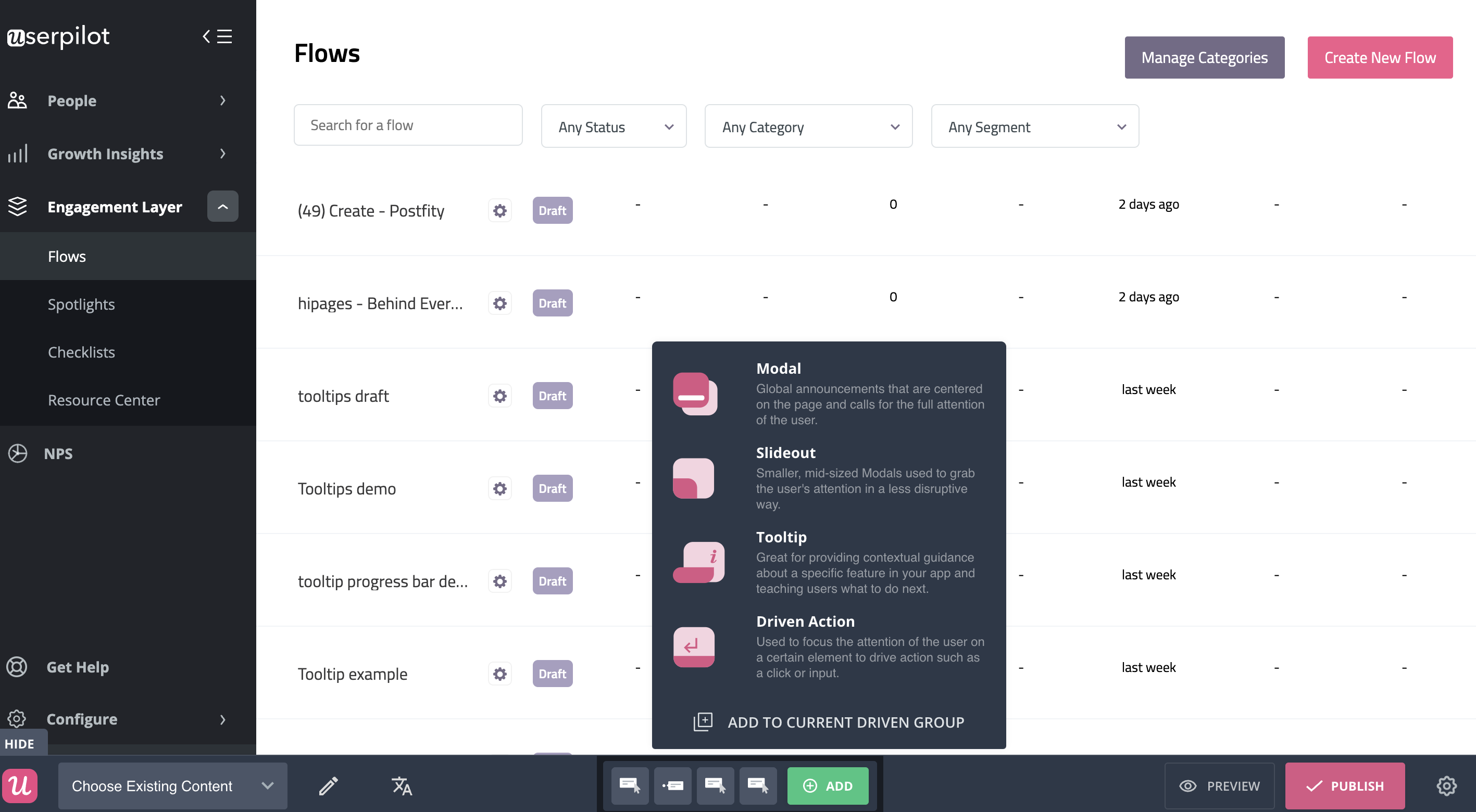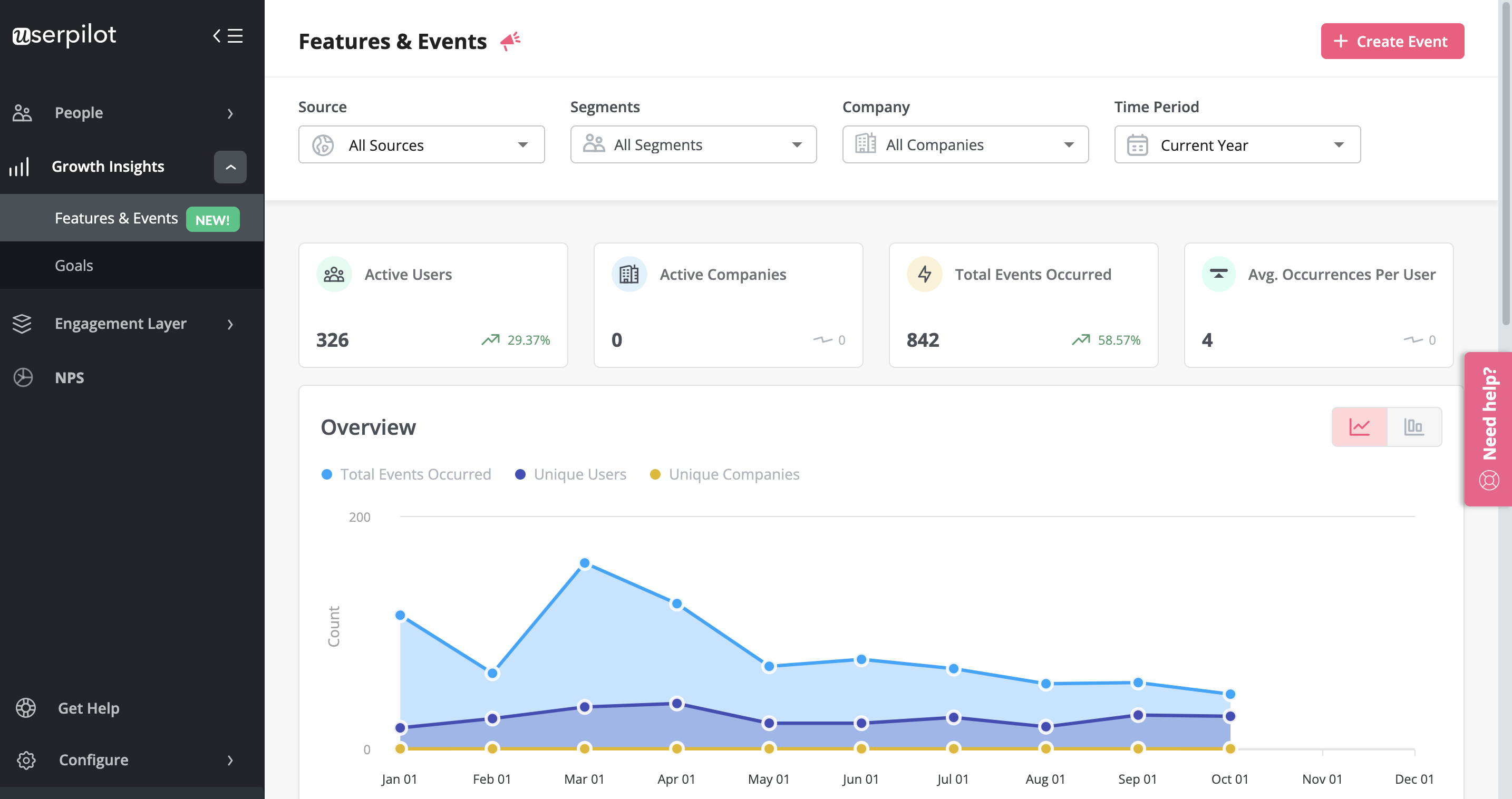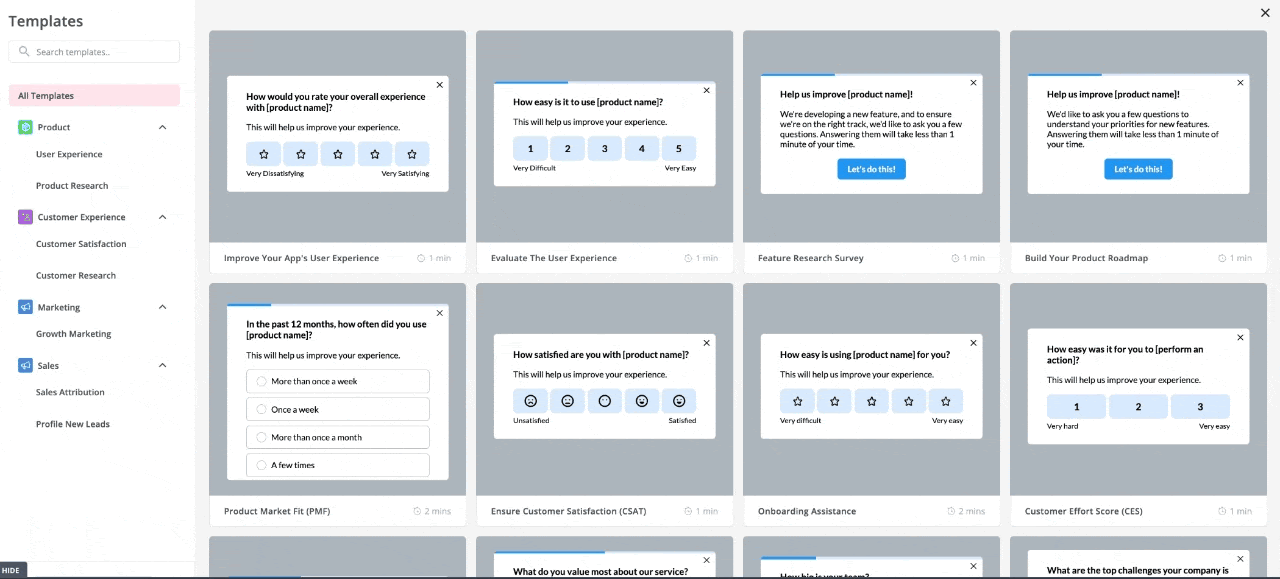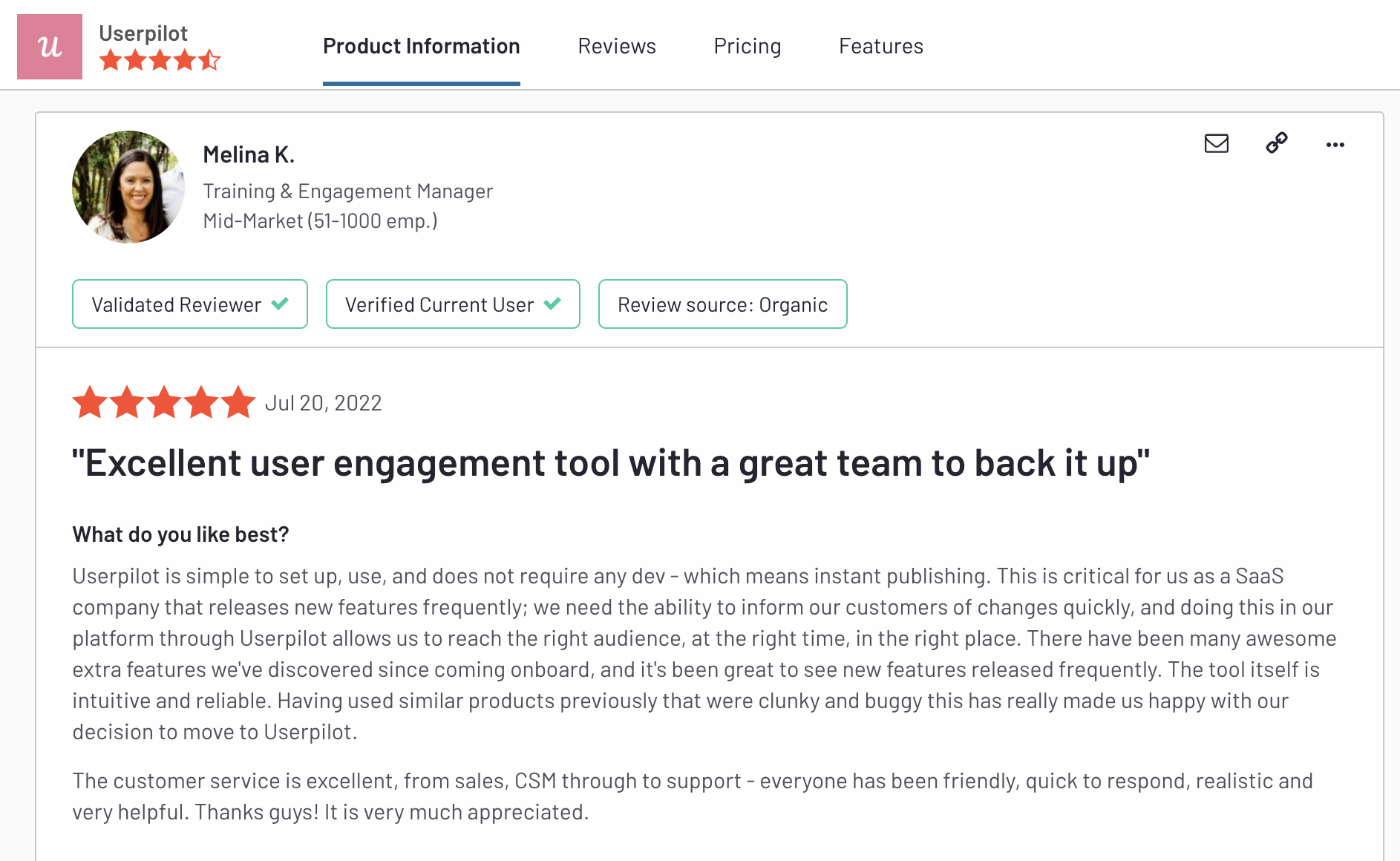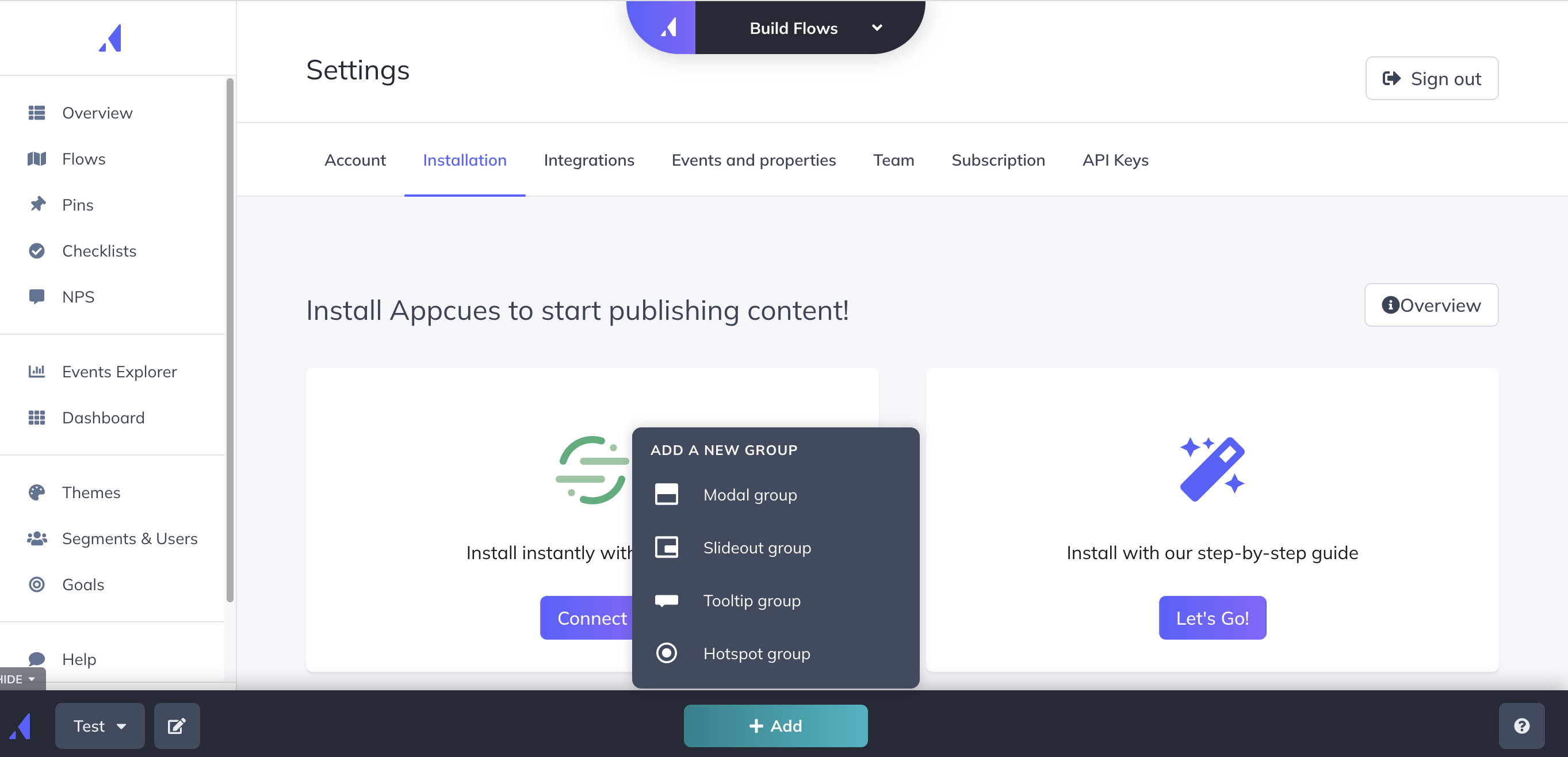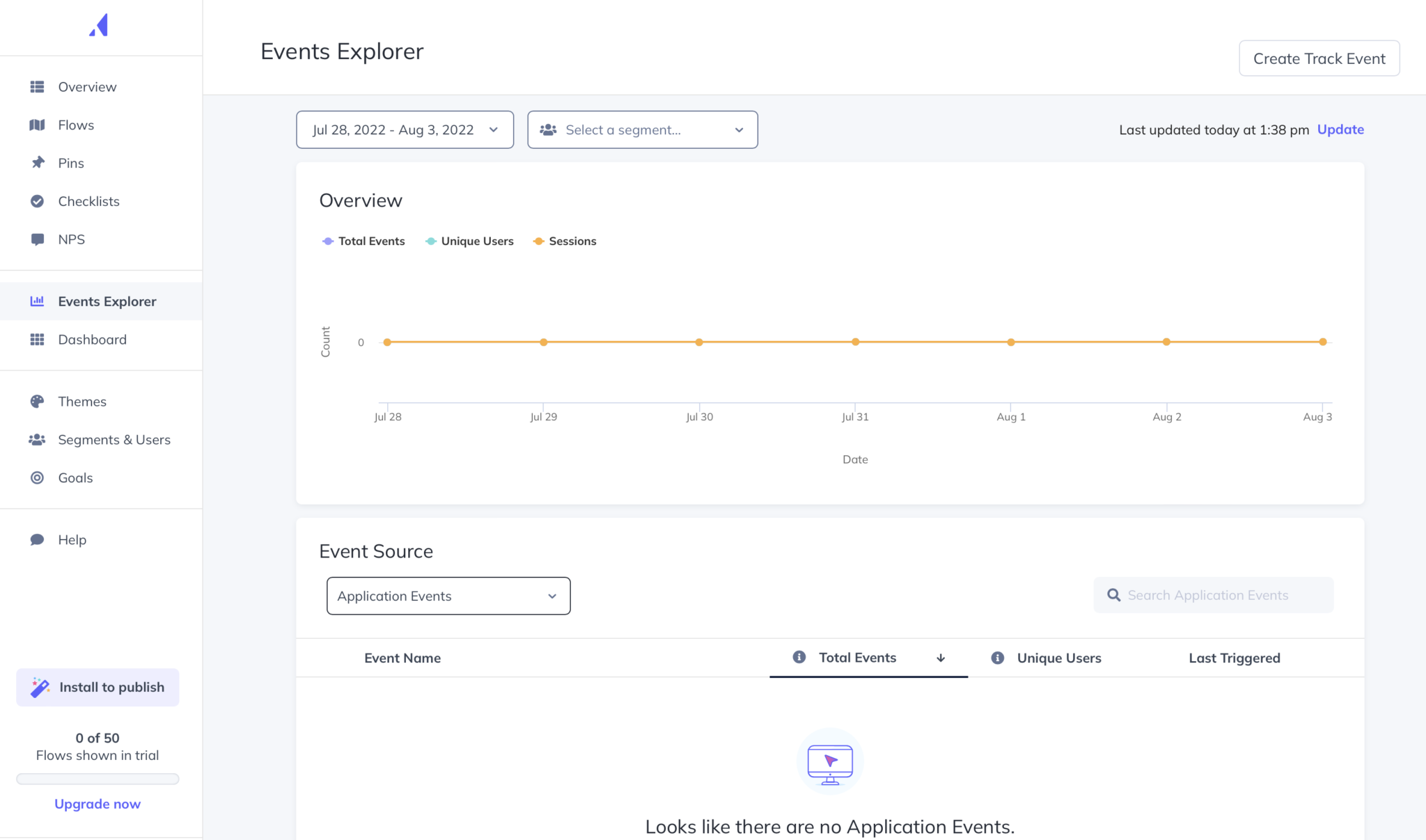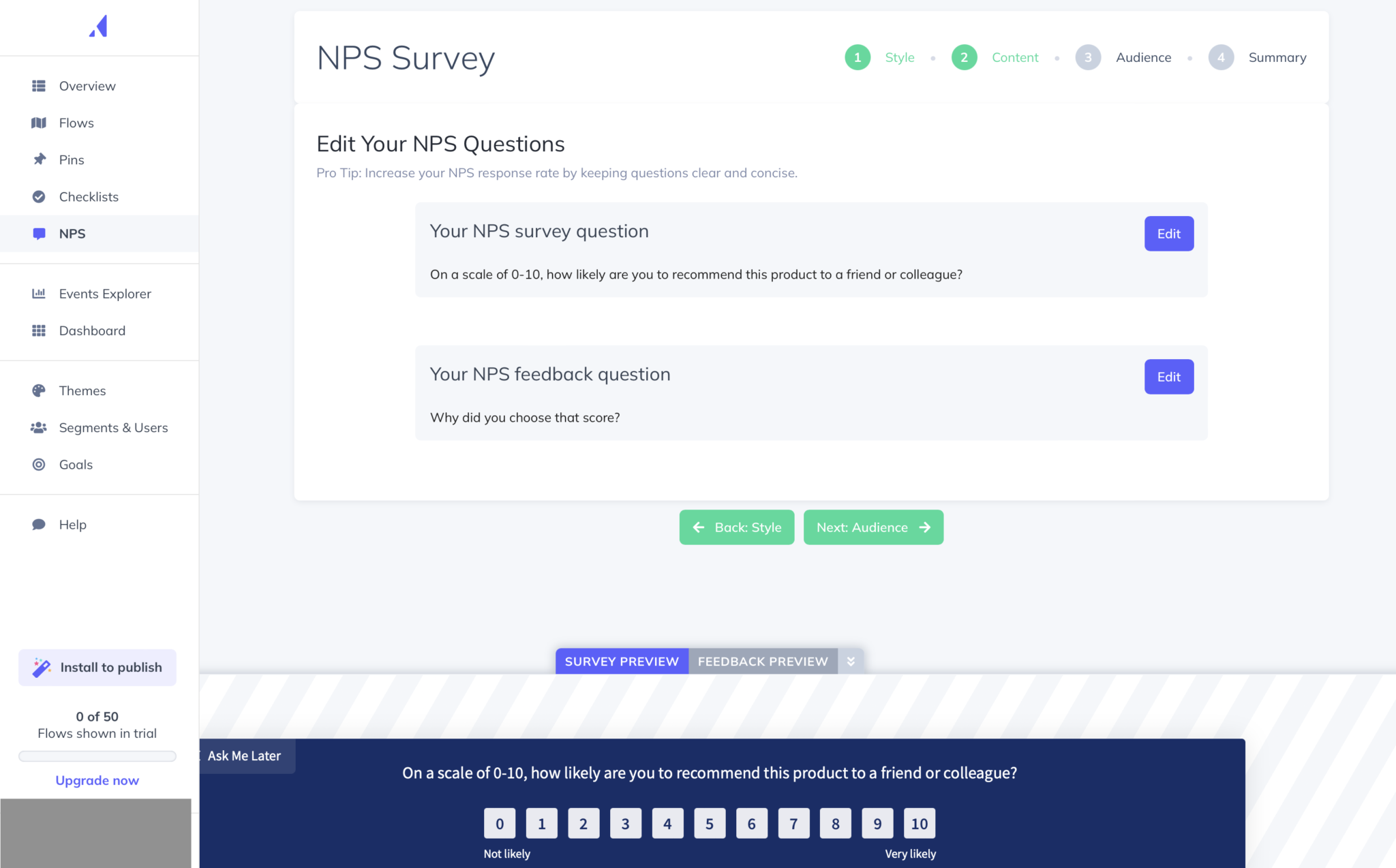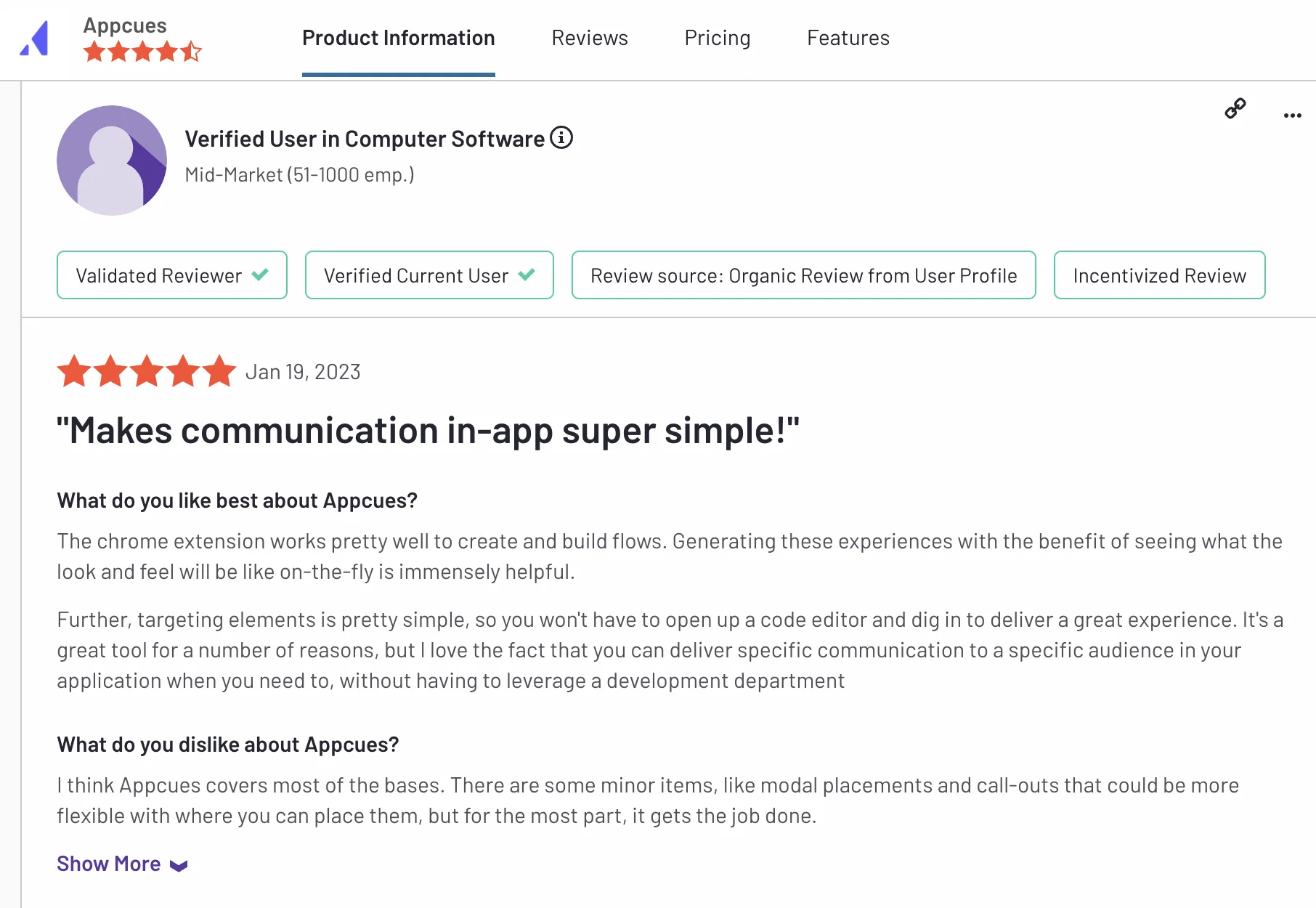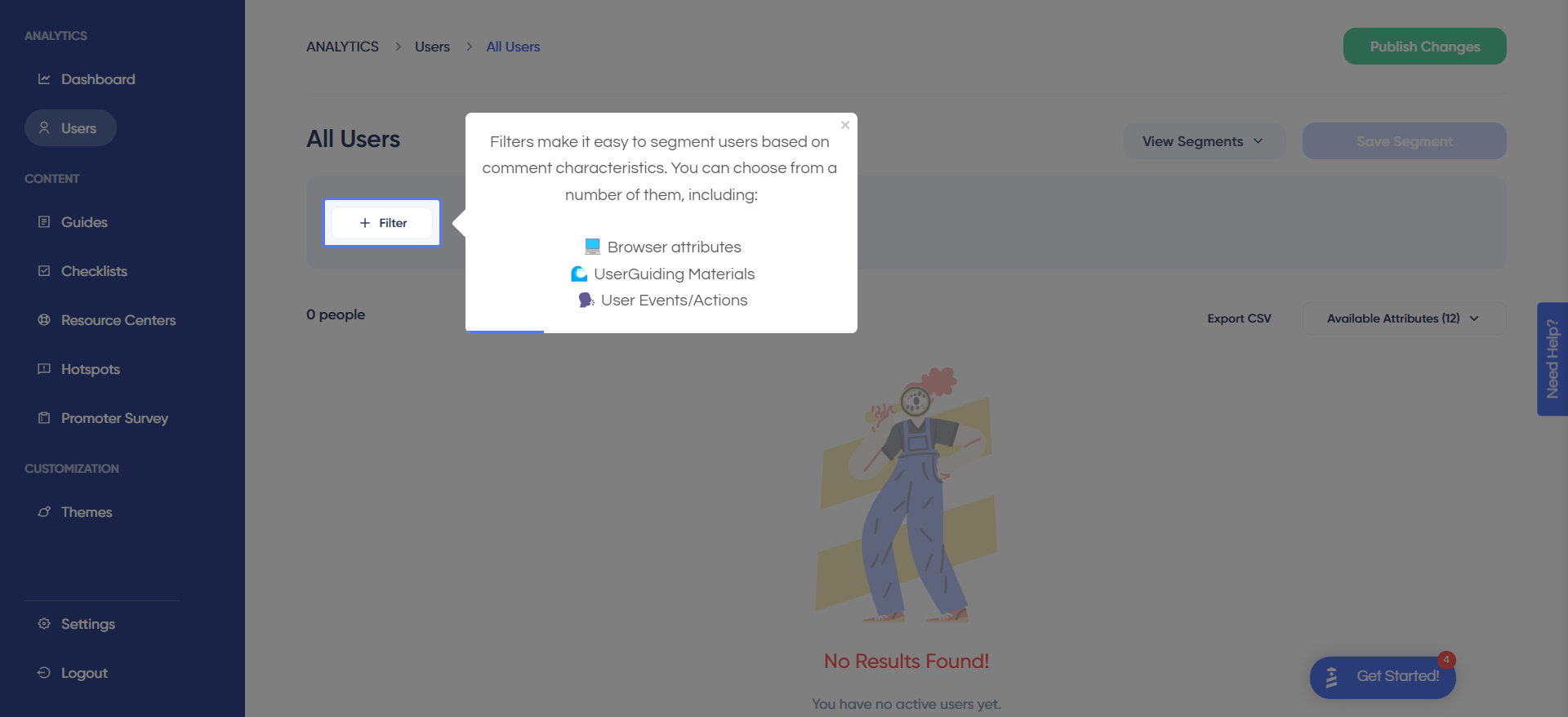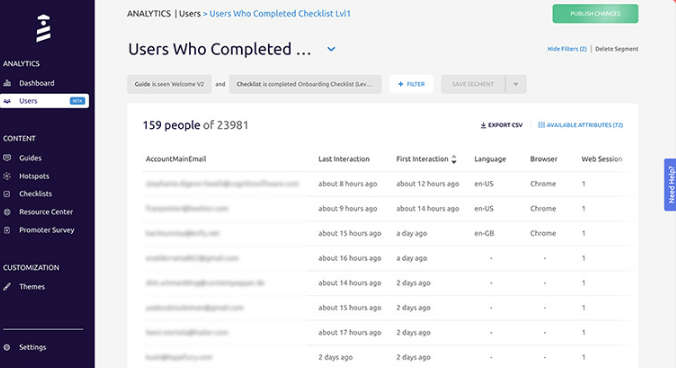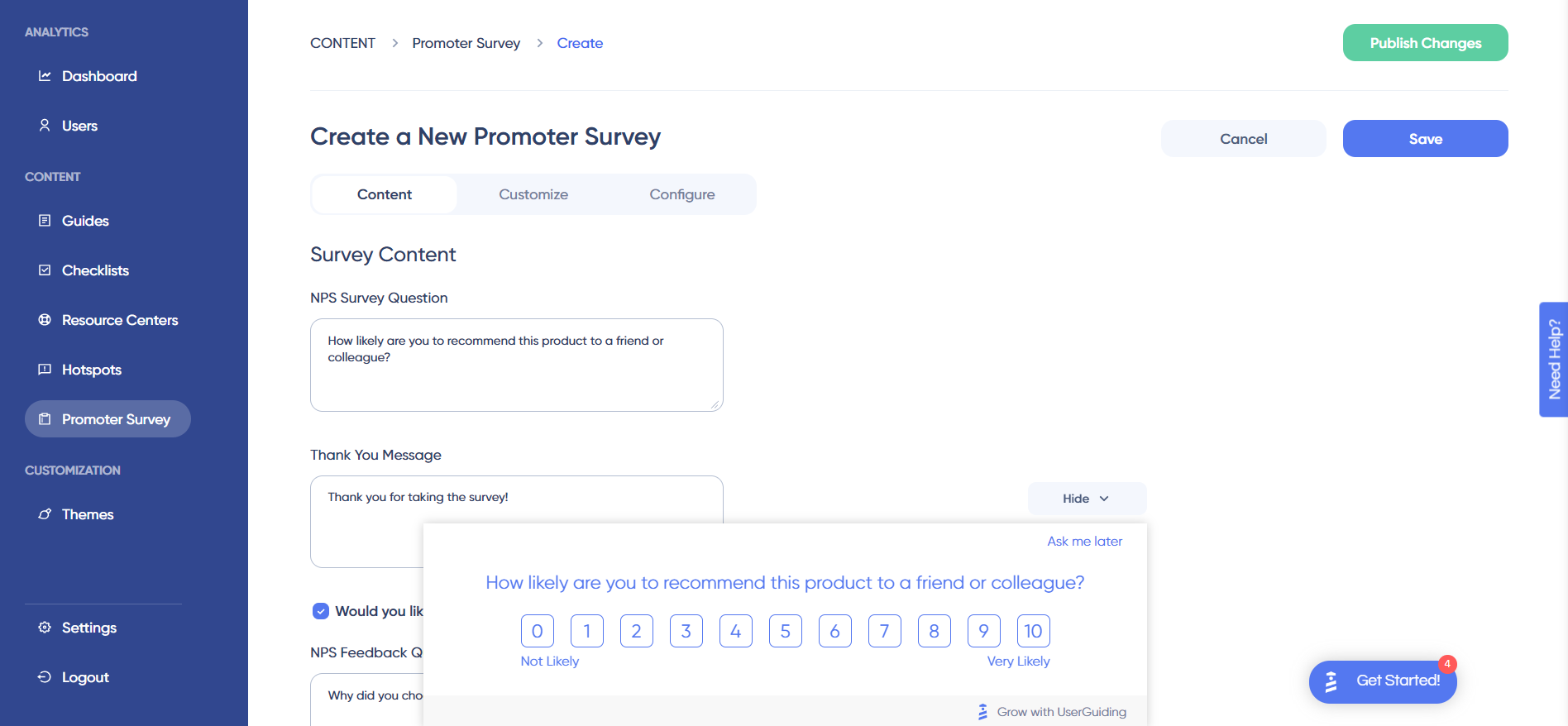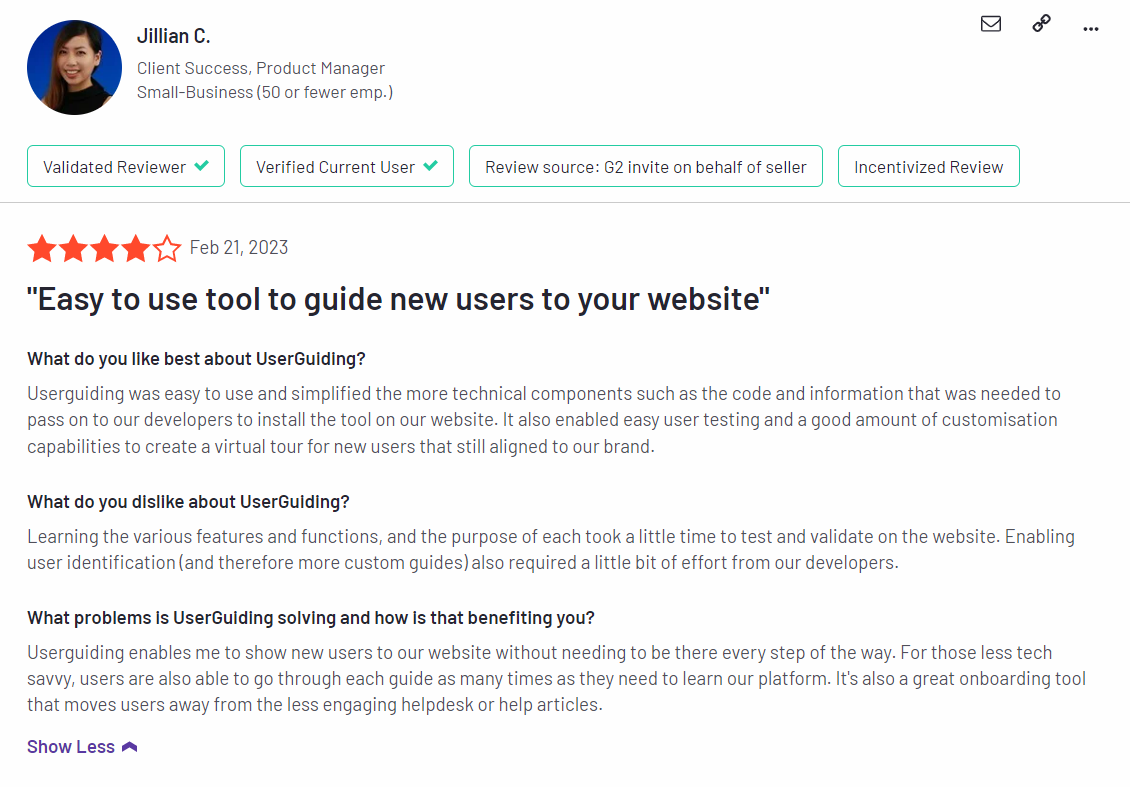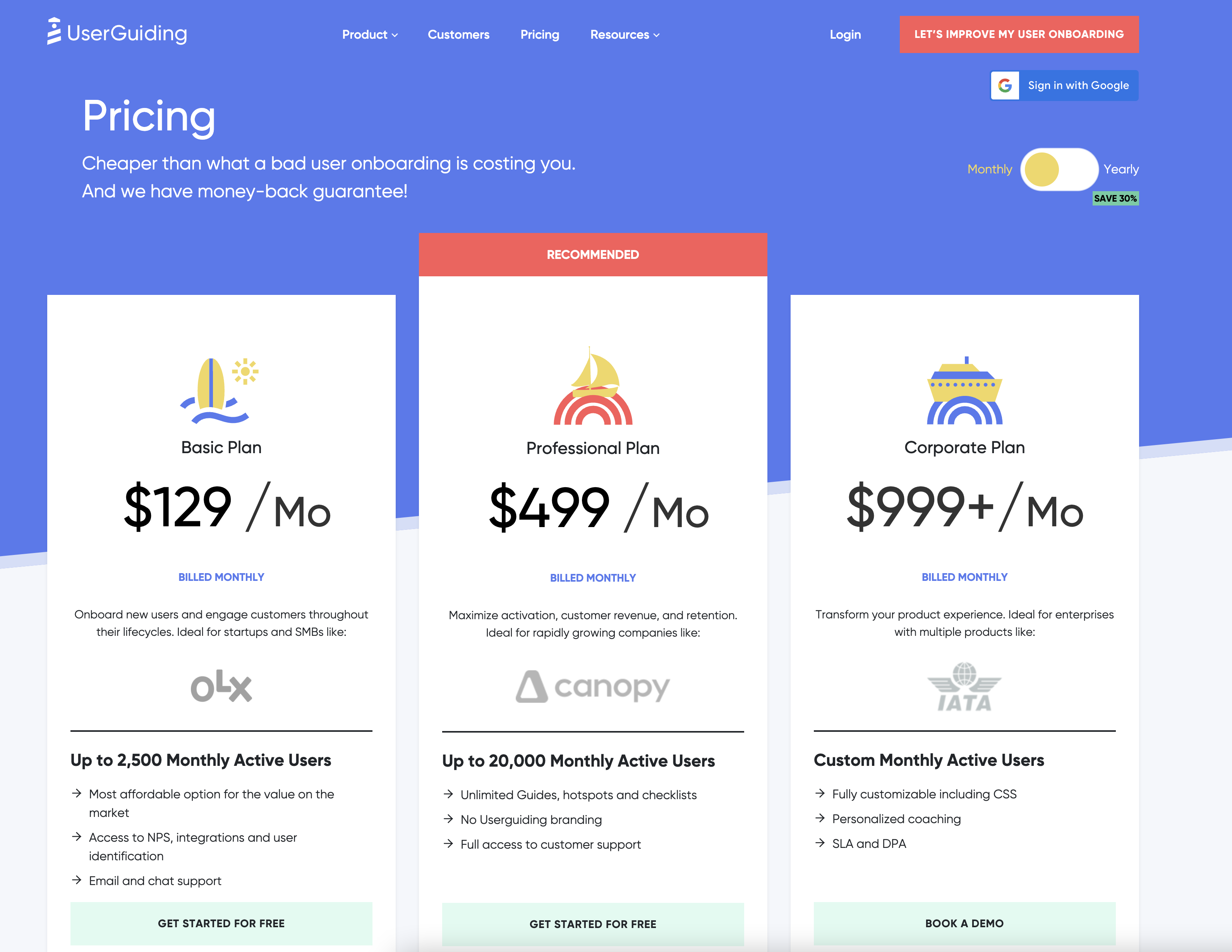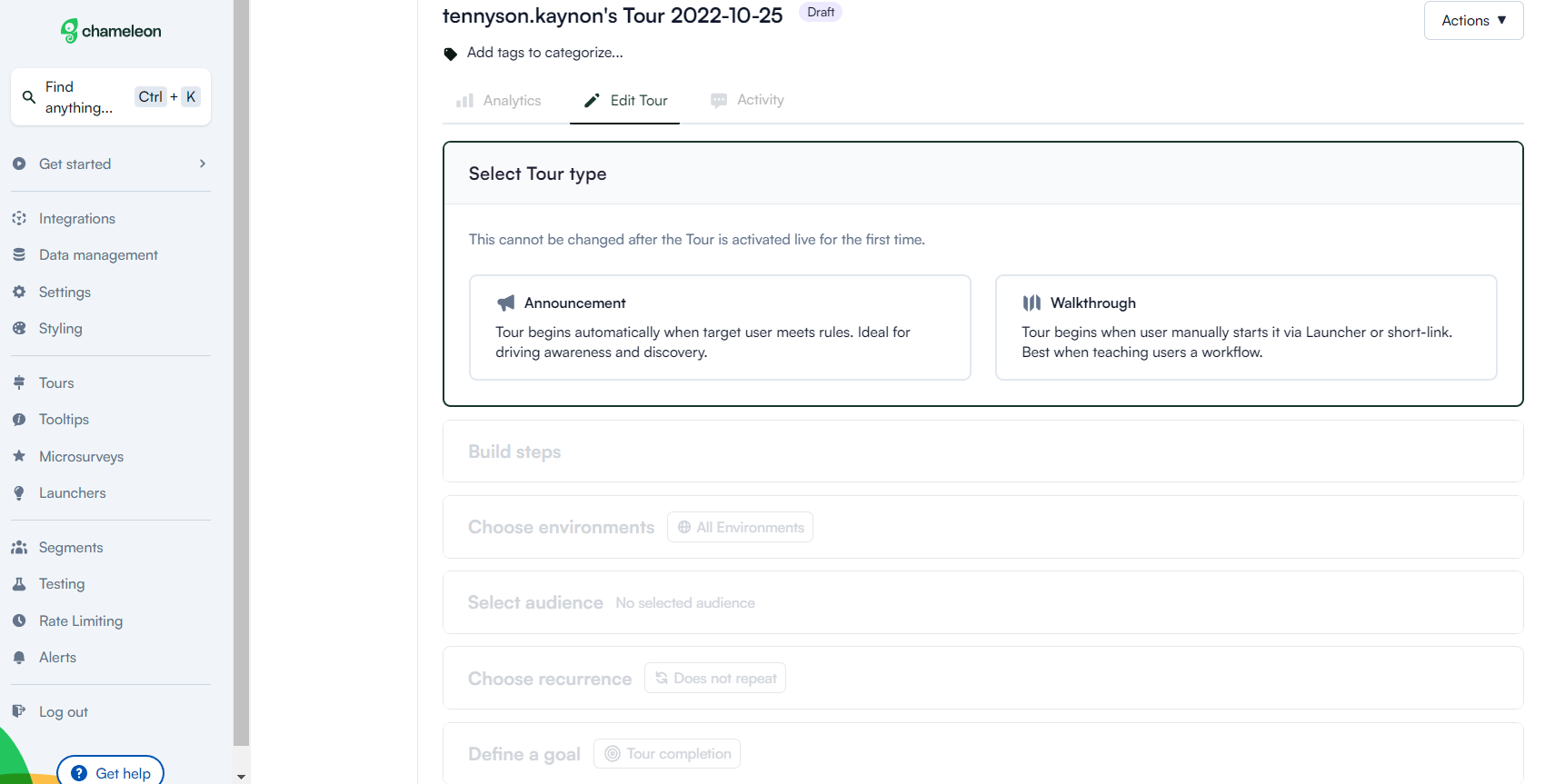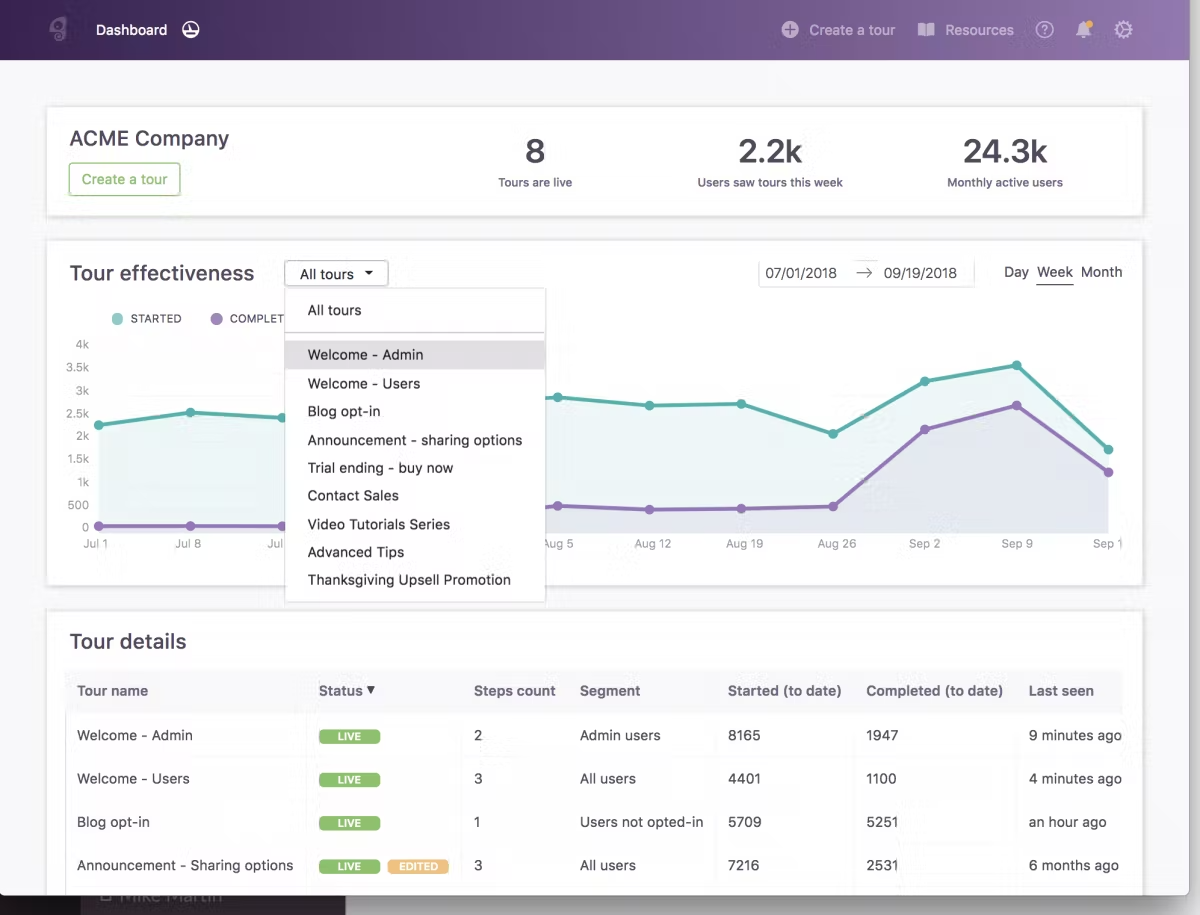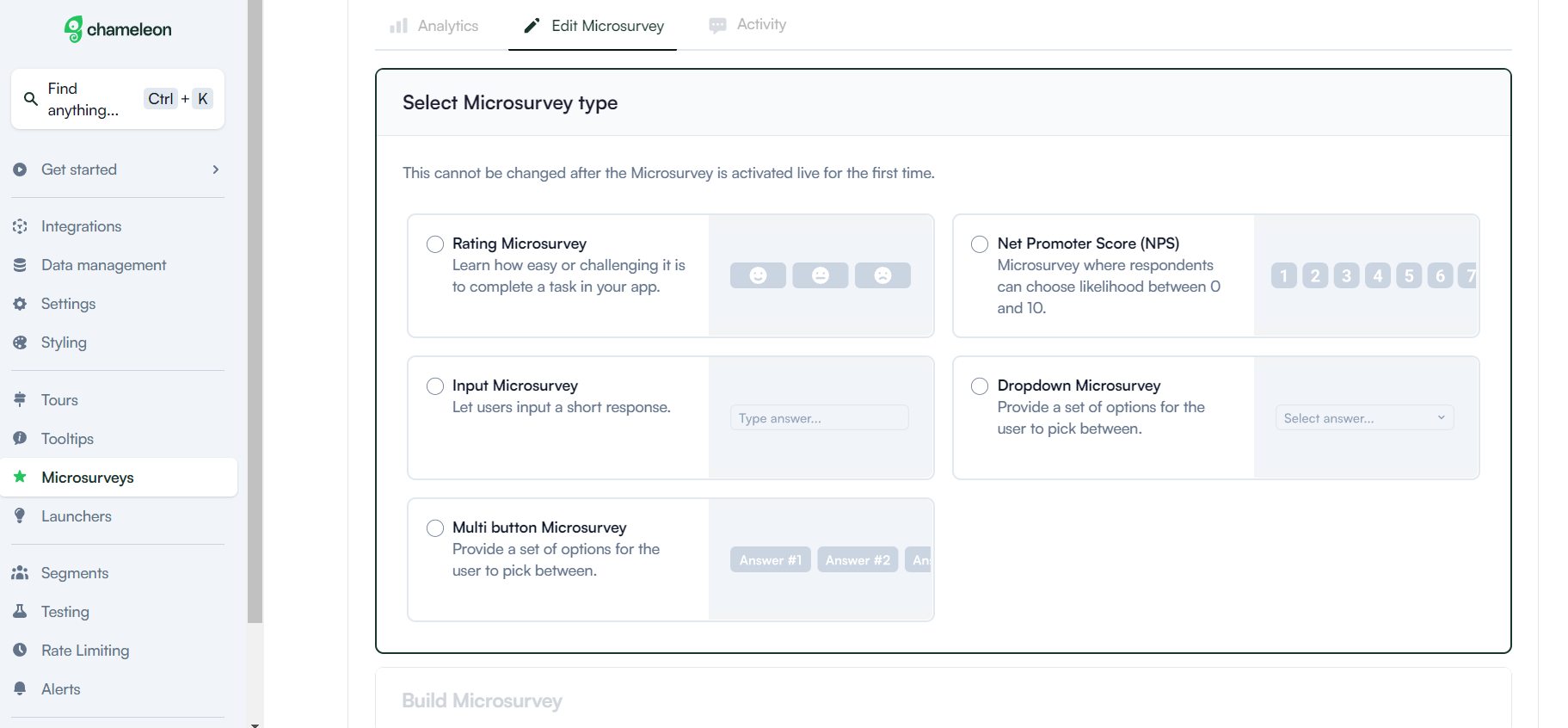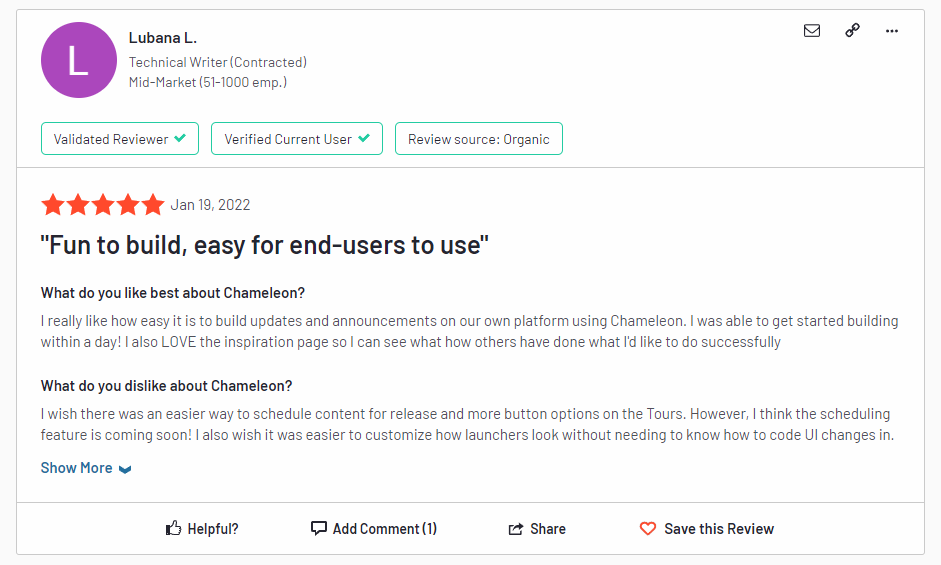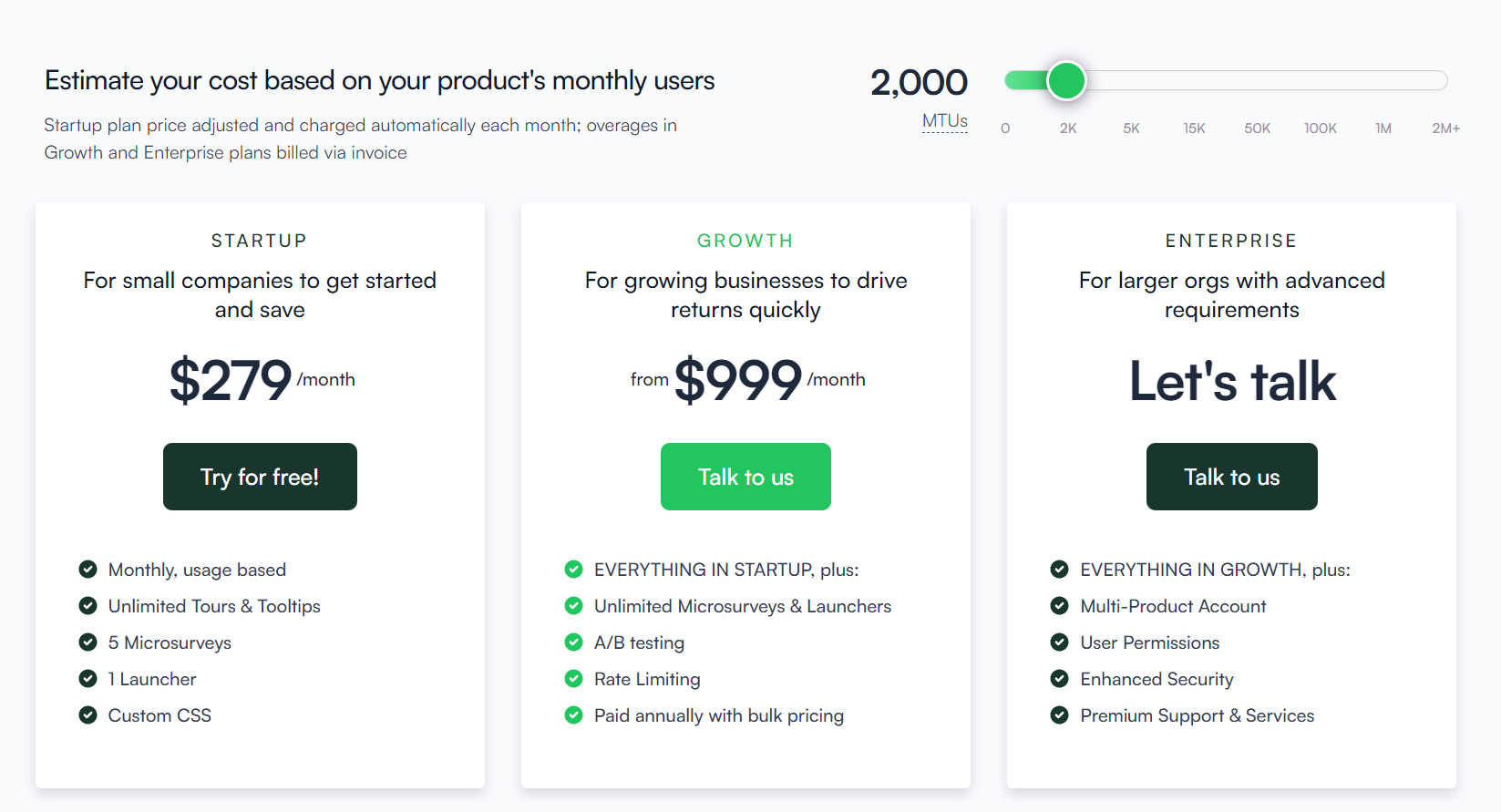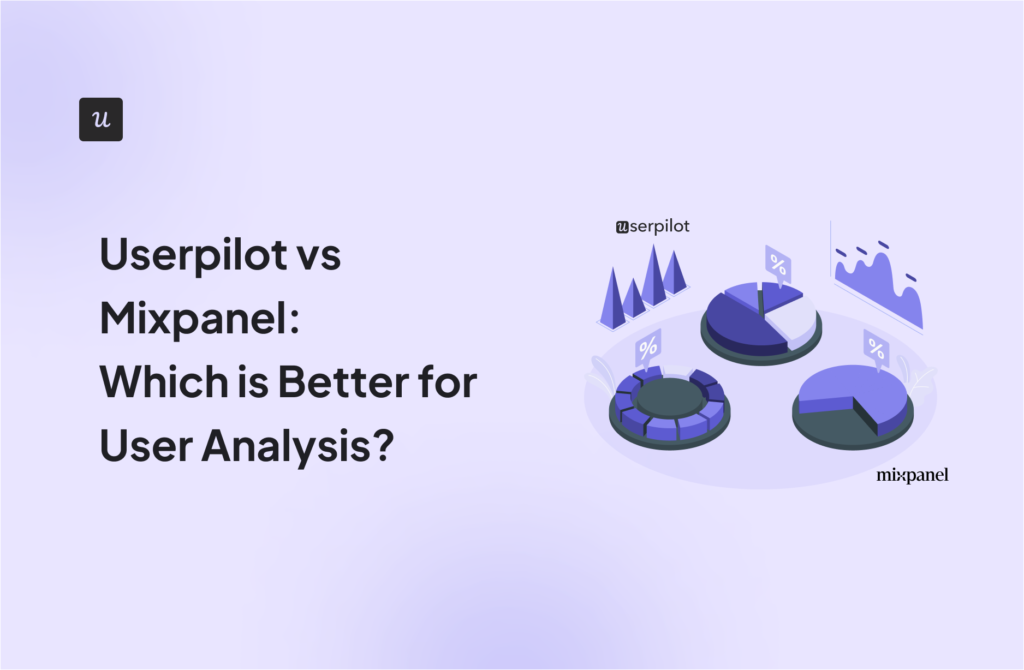
Looking for a good user onboarding tool and wondering if LouAssist is the best option for your SaaS company?
There are plenty of LouAssist alternatives on review sites, but they don’t make the choice any easier.
The crux of the issue is – to make the right choice, you need to account for your priorities: your different jobs to be done, your budget, and the size of the company. But don’t worry – we’re coming to help!
In this post, we’ll discuss exactly that – which LouAssist competitor is best depending on the different criteria that different SaaS companies may have.
Let’s dive in!
Try Userpilot Now
See Why 1,000+ Teams Choose Userpilot

TL;DR
- LouAssist is a user-friendly product adoption and onboarding platform. It allows product teams to create captivating in-product experiences such as product tours, onboarding checklists, and feature announcements without coding. However, customization options may be limited, and it’s more focused on intuitive experiences than advanced analytics.
- Userpilot is a comprehensive digital adoption platform (DAP). It enables product teams to track product usage and user behavior to guide product development and optimize the user experience. In addition, it allows them to gather user feedback and design personalized onboarding experiences to drive product adoption. All of this is possible without coding.
- Appcues is another no-code user onboarding platform that helps non-technical teams track and analyze product usage. You can publish in-app onboarding tours, announcements, and launch surveys. Unlike Userpilot, the functionality is limited if you are using the basic plans.
- UserGuiding is a product adoption tool that helps companies to create interactive user guides and in-app walkthroughs to onboard, engage, and retain their users. It provides a no-code solution that allows non-technical teams to design and implement in-app experiences without any coding skills. Overall, UserGuiding is a powerful tool that can help companies to streamline their onboarding process, increase user engagement, and drive customer retention.
- Chameleon is a digital adoption platform with a difference: while the other tools discussed are mostly no-code, Chameleon will require some developer involvement. Nevertheless, it’s a powerful and effective tool that works in a similar way to Userpilot and offers similar features: styling, analytics, templates, goals, A/B testing, and checklists. However, it doesn’t offer a resource center, or dedicated NPS, and it’s a lot worse value for money with limited features in the basic plan, which is over $150 more expensive for the same number of MAUs.
There is a better tool for your SaaS than LouAssist!

What is LouAssist?
LouAssist is a user-friendly product adoption and onboarding platform. It allows product teams to create captivating in-product experiences such as product tours, onboarding checklists, and feature announcements without coding. However, customization options may be limited, and it’s more focused on intuitive experiences than advanced analytics.
LouAssist for user onboarding
Here’s how LouAssist helps with user onboarding:
- You can create product tours and onboarding checklists to provide self-serve product experiences and guide users across their journey.
- It has custom themes to make the building product experiences fast.
- Create custom segments and decide who you want to target for your onboarding experiences. You will have pre-defined segments, called Turnkey segments so you can use them without prior set up.
All in all, LouAssist has good functionality for user onboarding but is lacking to offer self-serve support as there is no help center feature.
LouAssist for user analytics
With LouAssist, you can easily track product adoption and understand your customers better.
Let’s learn what insights LouAssist user analytics provide:
- You can track onboarding journeys and get an overview of tours step breakdown. This will help you understand whether customers are reaching key activation points.
- Select a time range and get access to metrics such as product tours total views, total completions, completion rate, average time in tour, etc.
- Create goals and monitor how customers complete those goals and where they get lost.
- Run A/B tests in just a few minutes, analyze and iterate.
- Additionally. LouAssist provides one click integrations with some of the most popular analytics platforms such as Mixpanel, Amplitude, Segment, etc.
LouAssist for user feedback
Here’s how you can collect user feedback with LouAssist:
- Run NPS and other short forms of in-app surveys to gather feedback at key moments.
- Choose one from the pre-built templates or start from scratch right in the LouAssist’s no code builder.
- Create custom segments or use Turnkey segments to target your surveys to specific groups.
- Analyze your Net Promoter Score in one dashboard, organize responses into detractors, passives and promoters.
LouAssist pricing
Compared to other companies in the market, LouAssist is a cheaper solution and their pricing plans can be a good fit for companies who do not have big budgets. Though as we have discussed above, some of the features are quite limited. Here are the pricing plans that LouAssist offers:
- Free: allows you to create two announcements, 1 product tour, 1 survey and basic checklists.
- Startup: includes unlimited product tours, announcements and one checklist and is priced at $87/month.
- Growth: offers unlimited product tours, checklists, announcements but the monthly active users shouldn’t exceed 10000. The plan costs $199/month.
- Enterprise: this is the most powerful plan and includes everything in the Growth plan but the monthly active users can be more than 10000. It costs $299.
LouAssist reviews
On the whole, users feel positive about LouAssist – here are some reviews from real users.
Love the fact that Lou has a diverse set of options to build that perfect experience while onboarding a new user or simply building tours for better product adoption. The Lou builder is highly user-friendly and easy to use, plus it works well on almost any URL I’m trying to build on. Tried a bunch of other options available in the market like storylane, usetiful, intercom to name a few and was drawn to Lou immediately for the kind of cost and features they offer! Currently, having fun building tours. – Drishti S.
It is very easy to use, intuitive. There are enough features to customize the modales and make them part of our product. The support is available and answers very quickly. For the free version, everything works fine. – Garance D.
However, there are some complaints. Here is what users don’t like in Lou Assist.
The browser extension seems heavy and it gets very slow sometimes. I think it’s because it works heavily on the page DOM, but still I hope it will be improved soon. – Daniele B.
It can be frustrating to build experiences for various devices as a change to one doesn’t populate across (also I wasn’t able to remove the existing devices and create new from the desktop version). – Elena N.
Pros of LouAssist
LouAssist is quite a good tool and mostly meets your user onboarding needs. Here are the main advantages to consider if you’re still deciding whether to try it or not:
- Easy to use platform. No need to have coding skills or rely on developers’ support.
- Create in-app product experiences that are aligned with your brand as you have full control of color, font, size, corner radius, etc. Images, videos and gifs are also included.
- Pre-built segments that are ready to go, such as new users, returning users, all users, and power users.
- You can collect and visualize the most important engagement metrics, analyze user behavior, and take action to improve customer experience.
Cons of LouAssist
LouAssist is a good product adoption tool but lacks in some areas. If you’re thinking of giving it a try you need to be aware of its drawbacks too. Here is a short list of LouAssist’s cons:
- Absense of in-app help center which means you can’t offer self-service support to your customers.
- Though it has integrations with some analytics and engagement tools, the number of integrations is not high and you might need a different tool to have all your data in one place.
- Lack of NPS response tagging which makes it difficult to analyze user sentiment.
3 reasons why you might need a LouAssist alternative
LouAssist is overall a good tool but it’s not perfect for everyone. Here are three main reasons why you might consider an alternative.
- The main drawback of LouAssist is that it doesn’t offer in-app resource centers so you can’t enable on-demand self-serve support for your customers.
- Though the pricing might seem competitive from the first sight, it has limited features and you have to choose the higher pricing tiers to access some basic features.
- Additionally, the tool isn’t great at integrations so you can’t connect your account to some of the most popular 3rd party software.
LouAssist alternatives and competitors
These are the top alternatives and competitors you may want to consider:
- Userpilot
- Appcues
- Userguiding
- Chameleon
Let’s have a look at them in more detail.
LouAssist vs Userpilot
Userpilot is a comprehensive digital adoption platform (DAP). It enables product teams to track product usage and user behavior to guide product development and optimize the user experience.
In addition, it allows them to gather user feedback and design personalized onboarding experiences to drive product adoption. All of this is possible without coding.
LouAssist is a great option for many SaaS companies, but in a lot of ways, Userpilot is better than LouAssist. Let’s explore the features of Userpilot, how it’s better than LouAssist and how it may fall short too.
Userpilot for user onboarding
Userpilot was built specifically for SaaS product teams that want to improve their user onboarding experience and boost user activation.
You can build a huge variety of user onboarding experiences and in-app guidance flows without needing to code.
Here’s what you’ll get when you start using Userpilot:
- Forget about coding in-app experiences: Userpilot is a no-code solution and only requires your dev to install a line of javascript inside your app and for you to download a Chrome extension that opens up the visual builder.
- Build in-app flows using the largest range of UI patterns (modals, slideouts, tooltips, hotspots, banners) and in-app onboarding experiences (checklists, microsurveys, NPS surveys, in-app resource center).
- Get access to a built-in NPS tool for collecting and analyzing user sentiment so you can improve your onboarding process based on real data.
- Create and track combinations of in-app events like clicks, hovers, and form fills, and then analyze all these interactions under your own custom events, which can be built without code or API calls.
- Use advanced product analytics and in-app flows analytics to identify where users need help and create granular user segments to trigger in-app experiences contextually (segment based on user identification data, in-app engagement, custom events, clicks, hovers, form fills, user feedback responses, NPS scores and more).
- Enhance the onboarding experience with in-app help by launching a Resource Center directly inside your app. Add in-app guides, and video tutorials, and give users access to search the knowledge base or reach out to support. Self-service has never been easier.
The best user onboarding is contextual and it happens right where the users need it, inside your app. There isn’t a better user onboarding tool out there that offers more value for the money than Userpilot.
Schedule a demo with our team and get ready to build the best onboarding experiences your users have seen.
Userpilot for user analytics
You can’t drive success, no matter what your goals are, without proper user analytics.
How would you know what needs to be improved?
When it comes to proper user onboarding that drives long-term product adoption, Userpilot has the right analytics to help you succeed.
Let me explain.
I’m not talking about product usage only. Analytics is about collecting customer feedback, tracking in-app behavior but also tracking how users engage with your in-app experiences. Right?
You need all of these for a complete picture of how healthy your product is. And then you need to be able to act on those insights.
That’s where proper user segmentation capabilities come in. And Userpilot has you covered here.
Userpilot has really improved in terms of its analytics functionality in recent years, and now offers the most robust functionality from all the product adoption platforms (including Pendo, which has always taken prime in user analytics).
In short, Userpilot analytics allows you to:
- Track all of your user interactions with your app – without coding- with the powerful feature tagging functionality, you can simply tag your users’ actions (clicks, hovers, form fills) with a no-code, point-and-tag editor on top of your product.
- See all your user clicks, activity trends, etc. in an easy-to-use dashboard – Userpilot also allows you to drill down into feature usage, down to individual user level, as well as company level.
- Analyze your user paths from up to 4 pages at a time, at a glance.
- Create ‘user funnels’ made up of feature tags and tracked events, and see where your users are dropping out of the funnel – and act on these drop-off points instantly with in-app experiences.
- Create and track combinations of in-app events like clicks, hovers and form fills, and then analyze all these interactions under your own custom events, which you can build without code or API calls.
- Create custom events that consist of feature tags as well – or combinations of tracked events you’ve passed through the Userpilot track script with features you have tagged with the Chrome Extension.
- The powerful trends overview allows you to filter your events and feature tags’ usage by segments, time period, and even company. This allows you to track and analyze event usage trends and even drill down to the individual users (or companies) who engaged with specific custom events and show them the right in-app experience.
- Apart from product usage data, Userpilot also has built-in analytics for in-app engagement with in-app flows and experiences.
- Analyze how users engage with your checklists or resource center modules, identify trends and A/B test different approaches to improve engagement.
- Last but not least, Userpilot allows you to use all that data to build highly granular user segments and reach users with the right engagement flows at the right time.
- You can even create user segments based on survey responses or NPS scores.
Now, with so much power on your hands – what are you going to do with all this data?
Userpilot for user feedback
There are two types of feedback you should be focusing on collecting to better understand the health of your product and users.
First, you have user sentiment which looks at user satisfaction and effort scores or loyalty (using NPS surveys). Then you may also want to collect feedback on the functionality of the product or specific features.
You can do all these with Userpilot. In short, you can:
- Collect and track (NPS) in-app with a built-in NPS widget that allows you to fully customize the survey look and feel, and set the trigger frequency and specific targeting.
- Analyze NPS scores, tag responses, and use the data to create specific user segments.
- Build and trigger in-app microsurveys like the classic PMF survey, or similar ones and mix multi-choice and open-ended types of questions to collect specific insights.
- Use different survey templates from Userpilot’s gallery (including Product Market Fit survey, CES survey, CSAT survey, Feature review survey etc.) and customize them to fit your needs.
- You can also build surveys from scratch, add different types of question types and use advanced branching logic.
- Be in charge of who gets which survey type and when with advanced segmentation capabilities, and of course, you can use the answers to segment your audience.
The advantage of using Userpilot for collecting feedback over other survey tools is that you can better control who sees the surveys but also you can instantly use the data collected to segment your user base and trigger the right experience for them.
For instance, if your users give you a low NPS or CES score because they think you’re missing a critical feature (that you actually have already), you can push an interactive walkthrough guiding them to find and explore this feature.
Userpilot reviews
Let’s check what real users like about Userpilot.
Userpilot is an incredible, user-friendly software that allows us to create unforgettable experiences for our clients! From basic to complex experiences, we have been able to do them all with ease! I would highly recommend this software to anyone who wants to provide their clients or users with the best product tour experience. The possibilities of what you can create are endless! – Tayla G.
Userpilot is simple to set up, use, and does not require any dev – which means instant publishing. This is critical for us as a SaaS company that releases new features frequently; we need the ability to inform our customers of changes quickly, and doing this in our platform through Userpilot allows us to reach the right audience, at the right time, in the right place. There have been many awesome extra features we’ve discovered since coming on board, and it’s been great to see new features released frequently. The tool itself is intuitive and reliable. Having used similar products previously that were clunky and buggy this has really made us happy with our decision to move to Userpilot. – Melina K.
Userpilot pricing
Compared to other tools in the market, Userpilot offers greater value for money as it provides all the necessary tools like engagement, analytics, feedback, and session replays inside one platform. Here’s the detailed Userpilot pricing breakdown:
- The Starter plan is priced at $299 per month (billed annually). It’s designed for small teams or startups with up to 2,000 monthly active users. It includes in-app engagement tools such as walkthroughs, checklists, and banners, along with limited segmentation (up to 10 segments), basic analytics, NPS surveys, and email/live chat support.
- The Growth plan is customized and intended for growing teams needing more advanced product analytics and feedback mechanisms. It includes all Starter features and adds unlimited segmentation and tagging, retroactive event tracking, advanced analytics like funnels and retention, as well as various in-app surveys including PMF, CES, and CSAT. It also enables localized content, content throttling, and access to a self-service Resource Center. Add-ons include session replays and mobile support. This tier comes with a dedicated Customer Success Manager, phone support, and domain customization.
- The Enterprise plan is customized for large organizations with more complex needs. It includes everything in the Growth plan plus additional features such as premium integrations, custom roles and permissions, bulk data management, SAML 2.0 SSO, and activity logs. It also offers priority support with service-level agreements, security audits, and custom billing options. Pricing for this plan is provided upon request.

There is a better tool for your SaaS than LouAssist!

LouAssist vs Appcues
Appcues is another no-code user onboarding platform that helps non-technical teams track and analyze product usage.You can publish in-app onboarding tours, announcements, and launch surveys.
Unlike Userpilot, the functionality is limited if you are using the basic plans.
There are many ways how Appcues is different (and in a lot of ways better!) from LouAssist. Let’s explore the features of, how it’s better than LouAssist and how it may fall short too.
Appcues for user onboarding
Appcues used to provide onboarding templates, which made it easy to use the tool. However, it provided a predefined way of thinking about onboarding all while having a higher price tag than other onboarding software. As of the time of writing (end of 2022), Appcues has removed its onboarding templates – without really replacing them with another solution.
Appcues allows you to design flows that make onboarding processes a breeze. These flows are what you use to create product tours and other in-app communication with users.
Here’s what you’ll get when you start using Appcues:
- Access to an easy-to-use UI that anyone on the team can handle for building in-app flows without coding.
- Building a product tour in Appcues is relatively easy. You just need to open their chrome extension on top of your application and start building your in-app experiences with a WYSIWYG editor. You simply select a UI pattern and customize it ‘live’, or point to the elements you want to e.g. append your tooltips to.
- Previously it was even easier – you chose one of its templates, they would basically create the product tour for you, and you just needed to customize each step. This limited the options for customizing but it was useful for beginners. We don’t know if Appcues plans to bring their templates back.
- You can also create checklists with Appcues (NOT available on the Essentials plan) and prompt users to take action. These are ok but have limited functionality (can’t trigger JS functions, or add gamification elements) compared to alternatives, such as Userpilot.
- Track UI engagement with Events explorer which allows you to tag elements without coding.
- Build custom user segments (up to 5 on the Essentials plan) based on user properties, flows, interactions, or events you set up in the events explorer.
Appcues for user analytics
Appcues user analytics is focused on the Event Explorer functionality and user segments that allow you to track user engagement and group users based on their main stage in the user journey.
Let’s look at each of these functionalities and how they can help. First, let’s explore their Event Explorer:
- Events Explorer makes it easy to view, validate, and visualize events in one place.
- Appcues defines events as user interaction with your features or flows inside your product’s UI and you can set these up with a few clicks.
- The Essential plan includes only 10 events. If you need more, you’ll have to upgrade to the Growth plan ($879/mo annually).
- This can be a little limited when you are trying to analyze product usage.
Now, let’s quickly see how Appcues segmentation can help. Appcues only gives you five user segments included in their Essentials plan, which isn’t a lot. It won’t be long before you need to upgrade the plan for more user segments.
The pre-defined user segments in Appcues (Evaluators, Beginners, Regulars, Champions) are very limiting if you want to access proper user analytics. Even building segments has its own limitations. You can create segments based on:
- User properties (when a survey was completed or when they’ve seen in-app flows)
- Flows interaction (has been completed or not?)
- Checklists (in progress, skipped, completed, not seen)
- Event (based on the ones you set up using event explorer)
- One of the predefined segments (Evaluators, Beginners, Regulars, Champions)
Appcues for user feedback
Can you use Appcues to collect user feedback? Of course.
Collecting data is not hard, analyzing and acting on it is where it gets tricky. What’s the purpose of having data if you can’t act on it?
If you want to track your NPS score over time and collect user feedback with short microsurveys, you can do that with Appcues. But to analyze the feedback data in-depth, you’ll have to use other tools.
In a nutshell, Appcues allows you to:
- Build and trigger NPS surveys in-app without coding.
- Edit the NPS survey questions.
- Target the survey at a specific user segment (or choose one of the predefined segments) and adjust the survey display frequency.
- Collect user feedback with short surveys built on top of modals: add numerical scale, open-ended questions, or radio button questions.
- On the flip side: you can’t tag your NPS/survey responses in-app and use these tags to segment your audience by them.
- You can’t analyze the responses in-app. You can only download a CSV report to start analyzing your data – and we all know how time-consuming that is.
Based on the above, when it comes to user feedback, Appcues is not the ideal tool, as it lacks the ability to segment users based on survey responses.
Appcues reviews
What do Appcues users share about their experience? Overall users feel positive about Appcues.
Here’s an example summarizing some key points about its features and the value it offers. You can find more reviews on G2 or Capterra.
The chrome extension works pretty well to create and build flows. Generating these experiences with the benefit of seeing what the look and feel will be like on-the-fly is immensely helpful.
Further, targeting elements is pretty simple, so you won’t have to open up a code editor and dig in to deliver a great experience. It’s a great tool for a number of reasons, but I love the fact that you can deliver specific communication to a specific audience in your application when you need to, without having to leverage a development department. – Verified User
Appcues pricing
All things considered, Appcues does not offer the best value for money compared to some Appcues alternatives – at $249 per month. If your product has 2,500 active users, the costs for different plans are:
- Essentials: $249/month (Up to 3 user licenses)
- Growth: $879/month (Up to 10 user licenses)
- Enterprise: Custom (Unlimited user licenses)
There is a better tool for your SaaS than LouAssist!

LouAssist vs UserGuiding
UserGuiding is a product adoption tool that helps companies to create interactive user guides and in-app walkthroughs to onboard, engage, and retain their users. It provides a no-code solution that allows non-technical teams to design and implement in-app experiences without any coding skills.
Overall, UserGuiding is a powerful tool that can help companies to streamline their onboarding process, increase user engagement, and drive customer retention.
There are many ways how UserGuiding is different (and in a lot of ways better!) from LouAssist. Let’s explore the features of UserGuiding, how it’s better than LouAssist and how it may fall short too.
UserGuiding for user onboarding
As a no-code onboarding tool, UserGuiding has numerous features that will help you create onboarding flows for your new customers and guide them throughout their journey.
Here’s what you’ll get when you start using UserGuiding:
- Create interactive product walkthroughs without disturbing your developers as it’s completely code-free.
- Build onboarding checklists and drive customers to the activation point by eliminating the guesswork on what the next step should be.
- Create interactive elements, such as product tours, tooltips, and pop-ups, to help keep users engaged and increase the likelihood that they’ll complete the onboarding process.
- Create a resource center to add different educational resources for your users.
Though UserGuiding is a great tool for startups that don’t have much money to invest in an onboarding tool, it has very strict limitations for the Basic plan.
You can only create a maximum of 20 guides and hotspots, 2 onboarding checklists, and 1 resource center. If you want to create unlimited guides with unlimited UI patterns, you should go for the Professional plan which can cost from $299 to $399.
UserGuiding for user analytics
UserGuiding’s analytics feature provides insights into how users are interacting with your onboarding flows and in-app experiences. Here are some of the functionality that UserGuiding’s analytics offers:
- Analyze the performance of your onboarding material in detail. This will allow you to figure out what’s working and what’s not.
- Track how users interact with your app in a given time period and identify product trends.
- Monitor real-time user engagement.
UserGuiding for user feedback
With UserGuiding, you can collect user sentiment data with NPS surveys and microsurveys even when using the Basic plan.
Here’s how you can collect user feedback with UserGuiding:
- Build NPS surveys without writing a single line of code.
- Adjust the thank you page and add a follow-up question to gather qualitative data and understand the reasons behind the scores.
- Customize the button texts, colors, and designs to match your brand.
- Set up custom audiences, segments, timing, and targeting rules to trigger the surveys.
The downside of using UserGuiding for collecting user feedback is that you can’t tag NPS responses to identify trends between scores. You also can’t create long survey forms as they neither support it in their native interface nor have integrations with other 3rd party tools to do the job.
Considering that, Userpilot undoubtedly offers you more value for money. You can build microsurveys, embed Typeform long surveys, collect and analyze NPS responses, and segment users based on scores and responses so you can trigger more personalized experiences. Get a Userpilot demo here!
UserGuiding reviews
If you check the product review sites, most people like using UserGuiding.
Here are some reviews from real users:
Creating guides/checklists are easy to implement. It does not take a lot of time to make adjustments when you need to make changes.
You can go live with a simple guide or checklist within minutes. I was able to go live within a few days of getting started. – Administrator in Computer Software
UserGuiding pricing
UserGuiding offers a range of pricing plans to suit different business needs. Here is an overview of their current pricing models:
- Basic plan: For a starting price of $99 per month, or $69 per month with an annual contract, the Basic plan provides access to the essential onboarding tools, but it does have some limitations to keep in mind. These include a maximum of 2500 Monthly Active Users, a single team member, a limit of 20 guides and 2 checklists, as well as UserGuiding branding on all UI patterns.
- Professional plan: With a monthly quota of 20,000 MAUs, the Professional plan offers unlimited guides, hotspots, and checklists. The plan starts at $399 per month or $299 per month with annual billing.
- Corporate plan: With custom MAUs, the Corporate plan provides access to all features as well as personalized coaching. The plan starts at a minimum of $699 per month, or $499 per month with an annual contract.
Additionally, they offer a 14-day free trial for all of their plans, allowing users to try out the product before committing to a paid plan.
There is a better tool for your SaaS than LouAssist!

LouAssist vs Chameleon
Chameleon is a digital adoption platform with a difference: while the other tools discussed are mostly no-code, Chameleon will require some developer involvement.
Nevertheless, it’s a powerful and effective tool that works in a similar way to Userpilot and offers similar features: styling, analytics, templates, goals, A/B testing, and checklists.
However, it doesn’t offer a resource center, or dedicated NPS, and it’s a lot worse value for money with limited features in the basic plan, which is over $150 more expensive for the same number of MAUs.
There are many ways how Chameleon is different (and in a lot of ways better!) from LouAssist. Let’s explore the features of Chameleon, how it’s better than LouAssist and how it may fall short too.
Chameleon for user onboarding
You can build widgets (launchers) and classic guides and tours with Chameleon as the main drivers of user onboarding.
Here’s how Chameleon’s main functionality helps with user onboarding:
- Chameleon’s product tours help you build flows for guidance. You can use several UI patterns for this: modals, banners, tooltips, and hotspots.
- You can customize the styling (font, color, opacity, etc) of your product tours and even add in some CSS styling if you want advanced branding.
- Launchers are where Chameleon is different compared to its competitors. These are in-app widgets that can open checklists, small help widgets, or notification centers. The downside is that you can’t have one launcher with multiple types of content.
- You can target content to different user segments based on multiple data sources including event triggering.
- Ability to use micro surveys with great customization and question-and-answer types.
- On Growth Plan and higher, you also get access to more functionality like A/B testing, multiple environments, localization (Enterprise plan only), and advanced integrations like Hubspot.
All in all, Chameleon has good functionality for user onboarding but will be very limited on the Startup plan as you only get one Launcher and five microsurveys.
To build contextual and efficient user onboarding you will need more than that. Considering what you get for the money, Userpilot offers much better value.
Chameleon for user analytics
Chameleon doesn’t shine when it comes to user analytics as they don’t really have their own dedicated analytics. But it does offer the minimum data you need.
It also integrates both ways with well-known analytics tools so this might justify the lack of their own reporting.
Here’s what you can expect from Chameleon’s product and user analytics data:
- A/B testing so you can measure the impact of your flows randomly on a sample group of users.
- You can track events using the integration available with popular product analytics tools or by setting up custom events via the API (you will need a developer to set these up).
- You can create user segments based on different user properties (attributes of the user), custom user events, experiences, and flows activity, or Chameleon tags ( added manually to specific users).
- Chameleon doesn’t have a dedicated analytics dashboard.
Chameleon relies a lot on their integration with powerful analytics tools so they haven’t really worked on building its own analytics. Due to this, you might find it limited when it comes to analyzing user engagement and targeting in-app experiences unless you also pay for the other tools.
Chameleon for user feedback
Here’s how you can collect user feedback with Chameleon:
- Build different types of microsurveys (limited to 5 on the Startup plan) such as NPS, CSAT, CES, Opt-in, and custom feedback types.
- Personalize the surveys as you wish (you will need help from a developer or may require CSS skills).
- You can select the survey’s frequency and whether you want it to repeat.
- You get access to basic completion reports. Most of the additional data will need to be analyzed in your analytics tools that Chameleon integrates with and sends data to.
- You will see your NPS score in the reports but for the rest of the microsurveys, you will need analytics tools.
It’s great that Chameleon lets you build beautiful microsurveys but it might not be the best tool if you want to analyze the data and most importantly act on it. For example, with Userpilot you can create custom user segments based on survey responses or NPS scores and trigger specific in-app flows for them.
Chameleon reviews
Users appreciate Chameleon’s versatile functionalities. Let’s see what they have to say about it.
I love the variety of formats we can build in Chameleon, from interactive tooltips to progressive tours and launchers! It’s also really easy to track performance of each of these and adjust accordingly. The interface still feels quite clunky whenever I’m in build mode. For instance, I don’t like that I have to use markdown and CSS when formatting text instead of having an inline styling menu to select from. Then there’s also the issue of surveys or tour steps appearing where they’re not supposed to, apparently mistaking an element in another page for the anchor. – Nikki D
Chameleon pricing
There is a better tool for your SaaS than LouAssist!

Conclusion – which of the LouAssist alternatives is the best?
As you can see, there are many different competitors and alternatives to LouAssist. We’ve discussed a few above – but which one is the best?
The answer is “it depends” – but we strongly believe that if you’re a mid-market SaaS company looking for a great user onboarding and product analytics tool, Userpilot is the best option for you.
Hopefully you found this post helpful. Let us know if you know any other good LouAssist alternatives – and if you need any help with how Userpilot is different, we are always happy to talk!

